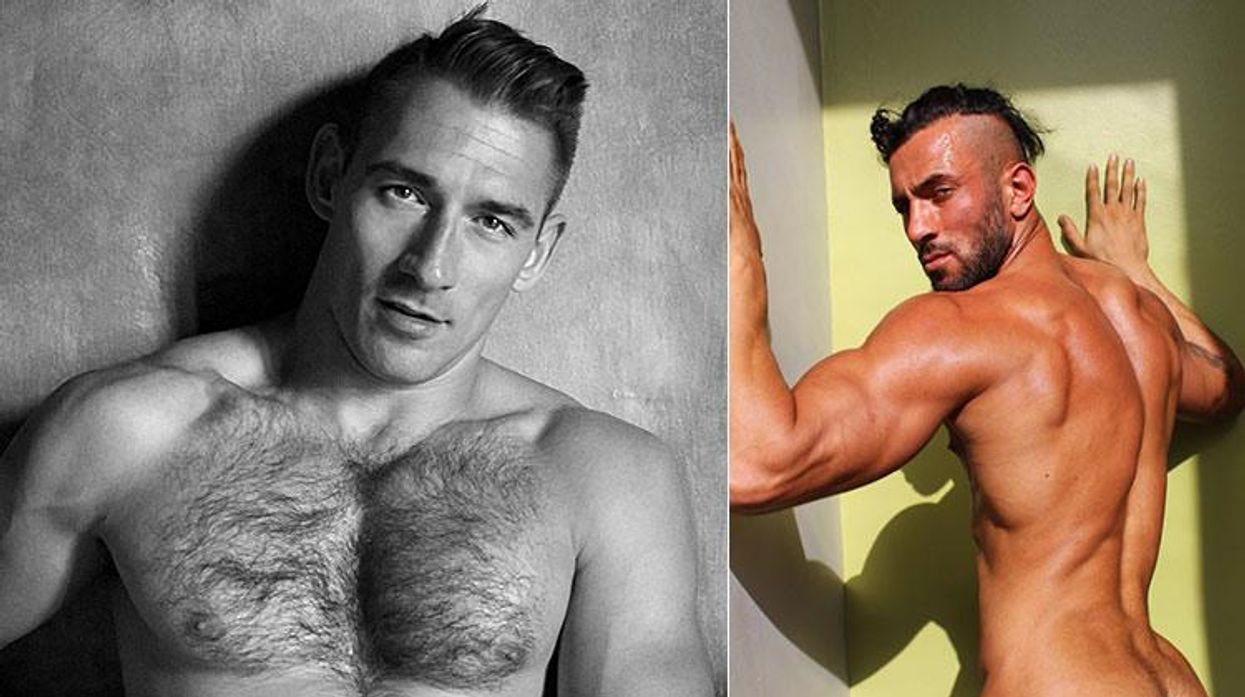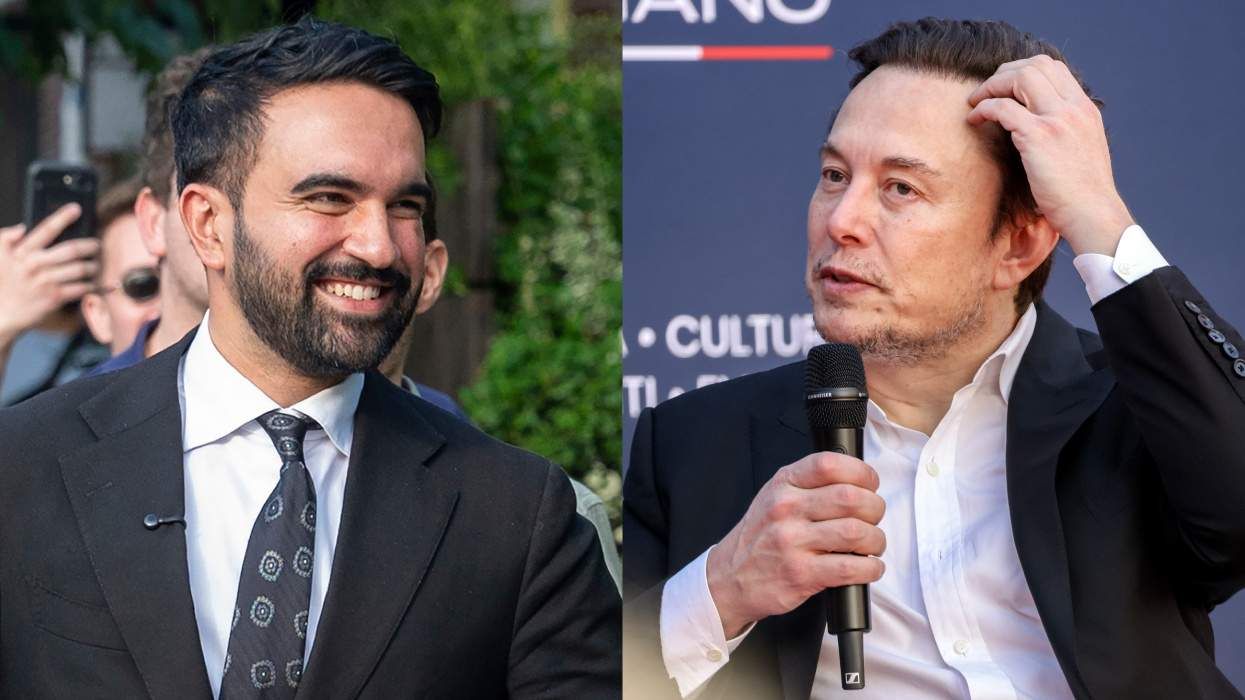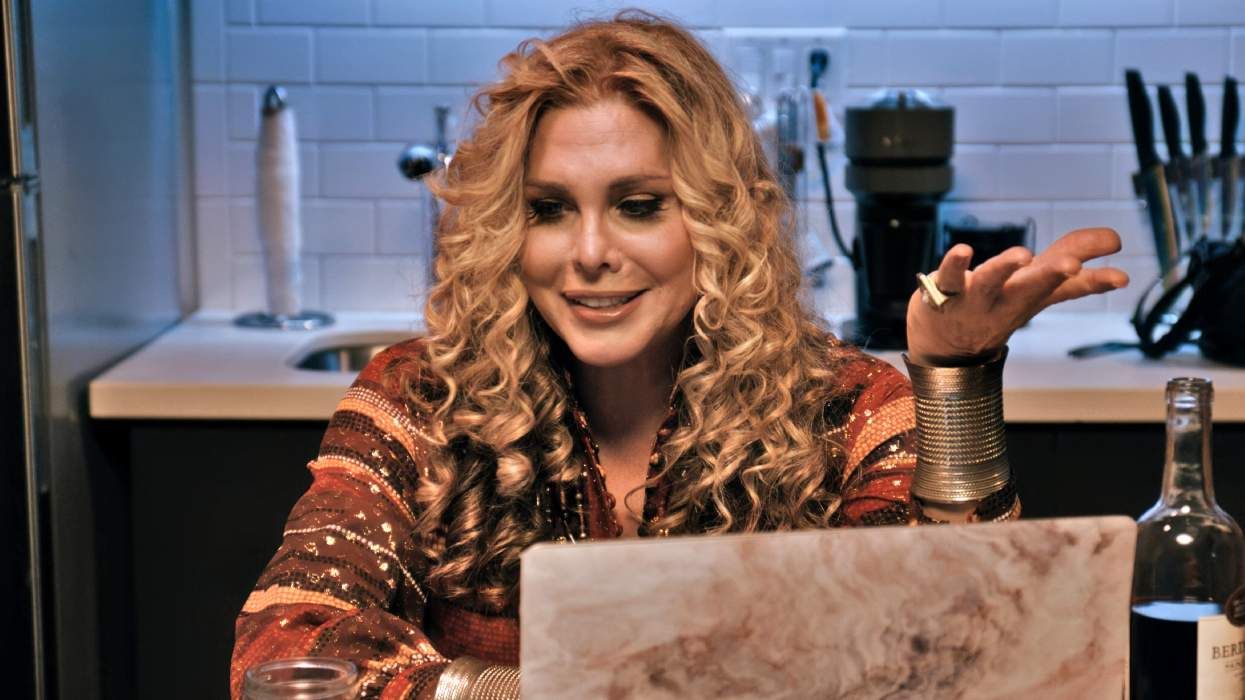Sex Sells. It Also Matters
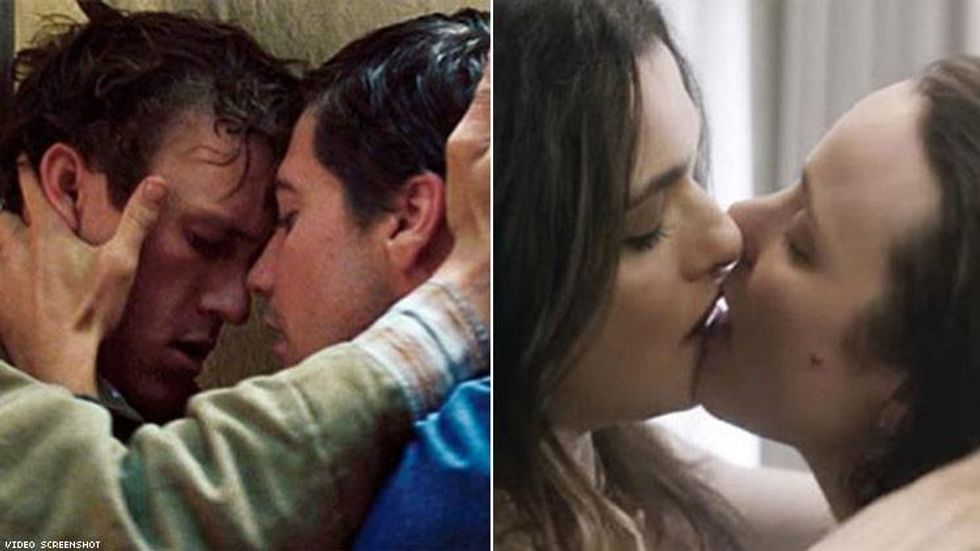
Sex in cinema can be exploitative, cheesy, pointless, and/or totally erotic. But when it comes to representation of LGBTQ people in cinema, sex scenes have the power to hold a mirror up to audiences who see themselves reflected in the action on screen. For queer filmgoers, sex scenes on the big screen have often been an entry-point to understanding one's own attractions and desires.
Throughout queer cinema history, there have been important sex scenes that have advanced representation. From Desert Hearts' honest portrayal of healthy lesbian desire, to Moonlight's Oscar-winning depiction of attraction and shame, to BPM's insistence on showing that the AIDS epidemic couldn't strip gay men of their basic humanity, sex scenes have been integral in the evolution of LGBTQ cinema.
Below is The Advocate's curated -- by no means comprehensive -- list of films with important sex scenes that changed how we were seen and how we see ourselves.
Desert Hearts (1985)

Desert Hearts boasts one of the first lesbian love scenes actually directed by a lesbian. Director Donna Deitch was aware of that fact while making the film, and she handled the sex scene very carefully. Her groundbreaking film tells the 1950s-set story of Vivian (Helen Shaver), who while en route to Reno for a divorce, meets and falls for the enigmatic Cay (Patricia Charbonneau). In the writing process, Deitch made a point to give the love scene a beginning, middle, and end that included dialogue. While filming, she didn't shy away from the slowness of their first kisses or the tenderness of a woman kissing another woman's breast. When editing, she adamantly refused to lay a score over the scene and opted to let the action speak for itself. All of her bold choices broke from portrayals of lesbian love that came before it. To this day, her work offers a still-fresh and still-steamy experience of female passion. --Allison Tate
Weekend (2011)

Sex only happens three times between Russell (Tom Cullen) and Glen (Chris New) in Andrew Haigh's revelatory 2011 film, Weekend -- and the first time you don't even see it. But it's definitely quality over quantity when it comes to everything in this hyper-realistic British gem. Aided by a genuine chemistry between the leads, the sex scenes are intimately shot; the camera is nearly as close to the (seemingly) naked bodies as it is in porn. The lack of gloss and abundance of realism -- hair is mussed, mouths gasp with both pain and pleasure, body fluids are strewn about, and everything is lit in a drab palette matching a cloudy U.K. day -- is something rarely seen in gay films, or any movie, for that matter. Clearly an inspiration for Alain Guiraudie's 2013 film Stranger by the Lake, the gay sex of Weekend was clearly made by someone who knows it, and someone who appreciates when it's damn good. --Neal Broverman
High Art (1998)

The Kids Are All Right director Lisa Cholodenko's debut feature includes a sex scene that achingly illustrates first-time sex with not only someone new, but with someone of the same gender for the first time, the thought of which was still pretty daunting at the time of the film's release. A fairly green editor for a photography magazine, Radha Mitchell's Syd falls in love with Ally Sheedy's photographer Lucy (who happens to be her neighbor) while trying to seduce the reclusive artist into shooting a new spread. Part muse/part editor, Syd and Lucy consummate their relationship while on a trip away from New York City. The scene begins typically enough with the passion and longing indicative of finally letting go. But partway through, Syd, tears up. When Lucy asks if it's "weird" for her, she replies, "I think I'm kind of in love with you." The scene beautifully gets to the heart of a first time that's also infused with overwhelming emotion. -- Tracy E. Gilchrist
Y Tu Mamá También (2002)

A good friend -- no longer with us -- recommended this Mexican film to me when it first came out. It was wonderful, he claimed, and hot; hot in a gay sense. So I rented Alfonso Cuaron's masterwork and thoroughly enjoyed it ... but what was gay about this movie? I rented the film from Blockbuster (it was 2002!) and its version edited out the movie's "climax" -- a three-way love scene between the film's two young protagonists, Tenoch (Diego Luna) and Julio (Gael Garcia Bernal), and a dying woman they met during a cross-country road trip (played by Maribel Verdu). Tenoch and Julio are ostensibly straight friends, but have a flirtation finally consummated in the fateful scene where the three make love. Cuaron films it beautifully, as the young men -- being pleasured by Verdu's character, Luisa -- slowly but suredly make their way to each other and share a passionate kiss. What exactly happens next is anyone's guess, as Tenoch and Julio wake up naked and, soon after, awkwardly head home. The love scene and the film seemed to honor the attractions and emotions shared between men and women of the same sex; feelings so often not acted on because of societal hang-ups and prejudices. --Neal Broverman
Blue Is the Warmest Color (2013)

As divisive as the elongated, acrobatic sex scenes punctuated with slapping and slurping sounds are in Blue Is the Warmest Color, there's no denying that the film from Abdelatiff Kechiche set tongues wagging with frank discussions about first love and the epic sex that can accompany it. The winner of the Palme d'Or at Cannes, the film's stars Lea Seydoux and Adele Exarchopoulos were so inextricable from the material that they were awarded the Palme alongside their director, making them the second and third women to win the prestigious honor in the festival's history.
For all of the scissoring under industrial lighting the film offers, the movie also kick-started an international discussion about the dangers of the "male gaze," even if the term in the vernacular became divorced from Laura Mulvey's original essay in which she spelled out the tenets of the "gaze."
Despite the sex scenes that had audiences squirming with either schadenfreude or delight, Blue Is the Warmest Color is a heartfelt coming of age and love story about young French women that boasts stellar performances from its leads. But the heartrending ending may leave viewers reaching for a bottle of red in which to drown their sorrows.
Tangerine (2015)

The simple fact that Tangerine stars actual transgender actresses playing transgender could qualify the film for a list about important sex scenes. Yet director Sean Baker's breakout film, which was shot entirely on iPhones, goes beyond simple representation. The scene follows transgender sex worker Alexandra (Mya Taylor) receiving a blow job from one of her regular customers, Razmik, while going through a car wash, complete with symbolic soap splashes! But it's actually the banality of the moment that gives it power. The look of relief on Alexandra's face when she sees a familiar customer's face, Razmik's casual dialogue, the placement of the camera as if the viewer were sitting in the backseat, and the lack of cuts, places viewers directly in the scene without judgment or a heightened reality.
Additionally, a trans woman is on the receiving end of the blow job and thus the recipient of physical pleasure instead of the giver, a version of transgender sexuality rarely discussed in any medium. The scene's empathy for both of its subjects as well as Baker's ability to avoid stereotypes and voyeurism makes it one of the most artful blowjob scenes of all time, and an important moment in transgender representation in cinema. -- Jessie Earl
Taxi Zum Klo (1980)

An enduring revelation, Frank Ripploh's Taxi Zum Klo (Taxi to the Toilet) juxtaposes a German schoolteacher's professional life with his after-hours hobby of cruising. Shot during that halcyon moment when gay subculture thrived and before AIDS decimated the community, the film is utterly refreshing in its depiction of gay sex free from shame, fear, and pathos. The film's multiple sex scenes that include full-frontal male nudity are raw, graphic, realistic, and often touching. Taxi Zum Klo may best be remembered for its literal depiction of water sports, but all of its overt sexuality is really a beautiful affirmation of gay male desire. -- Tracy E. Gilchrist
Law of Desire (1987)

Pedro Almodovar's meta-thriller, which takes the exploration of the camera as a mediator to new levels, stars future international superstar Antonio Banderas as Antonio, a closeted man who meets, has sex with, and becomes obsessed with Pablo (Eusebio Poncela), a director of erotic films. Shot at the height of the AIDS epidemic, the film's portrayal of masturbation for Pablo's camera (and ultimately Almodovar's) and anal sex invited criticism. Homophobes disliked its unapologetic depiction of gay desire and members of the gay community were frustrated with Almodovar for shooting a sex scene in which Pablo penetrates Antonio without a condom. Still, Almodovar's brash representation of gay sex was eye-opening to audiences of the era, and he's always been nothing if not controversial. -- Tracy E. Gilchrist
Professor Marston & the Wonder Women (2017)

Following the sexiest lie detector test scene ever put to film, Professor Marston and the Wonder Women's first of many sex scenes represents the culmination of the love triangle between the titular Marston (Luke Evans), his wife, Elizabeth Holloway Marston (Rebecca Hall), and their research assistant, Olive Bryne (Bella Heathcoate). Shot with passion and precision by out director Angela Robinson, the film's first sex scene plays into the film's themes of bondage and submission as well as female empowerment and oppression. The three lovers are equal and trusting participants in their affair, which in a story (and artistic medium) dominated by the male gaze is no small feat. While the film takes some liberties with the true story behind Wonder Woman's creator, the initial sex scene represents one of the few positive on-screen portrayals of an openly sexual and healthy polyamorous relationship as well as of oft-misunderstood fetish art. -- Jessie Earl
Wet Hot American Summer (2001)

The first time I saw a gay sex scene was in a living room with my straight friends in high school. We had gathered to watch the cult classic Wet Hot American Summer -- a satirical sex comedy at the fictional Camp Firewood in 1981. In the film, nearly everyone is trying to get laid on the last day of summer camp, including, to the surprise of my then-virgin eyes, McKinley (Michael Ian Black) and Ben (Bradley Cooper). Unbeknownst to their clueless fellow counselors (who are conspiring how to find a hookup for McKinley), the pair meet in a shed for a rendezvous of sweaty, passionate lovemaking. I'll never look at knee-high socks or a soccer ball, which gets kicked around in the scene, in quite the same way. Later, McKinley and Ben even have a lakeside marriage ceremony.
The sex scene in Wet Hot American Summer was groundbreaking precisely because it existed outside of a gay movie, which means that the film's many straight fans, including my friends, had the opportunity to see queer love in a positive light. Moreover, although the film was a financial flop at the time of its release, it paved the way for mainstream productions like this year's Blockers that incorporate LGBTQ characters in the sex-comedy oeuvre. --Daniel Reynolds
Je, tu, il, elle (1974)

More than a decade before the benchmark Desert Hearts or the great lesbian-themed films of New Queer Cinema like Go Fish, The Watermelon Woman, and The Incredibly True Adventures of Two Girls in Love, Belgian auteur Chantal Akerman (Jeanne Dielman, 23 quai du Commerce, 1080 Bruxelles) directed herself in an unabashed, raw depiction of female desire and sex in Je, tu, il, elle. Minimalist to the point of bordering on experimental, Akerman, who was queer, plays Julie in the triptych of a film that sees her waiting for her female lover before heading out on a road trip to find her. The character engages sexually with a trucker she meets along the way before reuniting with her girlfriend (Claire Wauthion). Breaking all previously set boundaries of how to depict female desire on screen and circumventing what would become known as the dreaded "male gaze," Akerman directed herself and Wauthion in a raw 10-minute sex scene that eschewed glitz and glamour. -- Tracy E. Gilchrist
Moonlight (2016)

The fact that he's queer is just one of the fascinating aspects of Chiron, the strong, sensitive protagonist of Barry Jenkins's Oscar-winning Moonlight. His relationship with adults and his tenacity at navigating life are really at the center of the film. But when Chiron's sexuality does emerge with clarity, it's depicted with wonder and catharsis. Teenage Chiron (played by Ashton Sanders) encounters friend and classmate Kevin (Jharrel Jerome) on the beach during a windy evening. Chiron's attraction to Kevin is soon revealed to be requited -- a shared blunt leads to laughter and admissions, and then kissing and, finally, a hand job for Chiron. After cumming, Chiron apologizes. "What do you gotta be sorry for?," Kevin asks, reminding him that was just happened wasn't shameful -- just as Jenkins's framed it, the encounter was beautiful. No doubt, many gay viewers were reminded of their own erotic, forbidden first time. --Neal Broverman
Disobedience (2018)
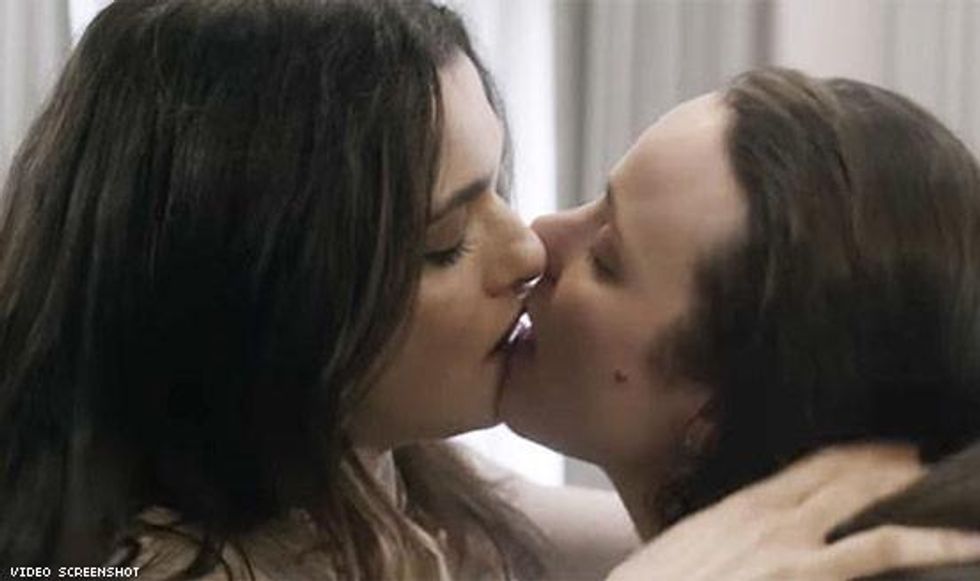
Oscar winner Rachel Weisz helped shepherd Naomi Alderman's novel about love between women in the cloistered Orthodox Jewish community of North London to the big screen. The movie, from A Fantastic Woman director Sebastian Lelio and with a script from out writer Rebecca Lenkiewicz, investigates the parameters of women's sexual agency that culminates with a sex scene that releases years of pent-up sexual repression.
Several critics have clung to the details of the deeply passionate scene, which includes an intimate exchange of fluid (that also functions metaphorically) that has rarely, if ever, been rendered on screen in a major film about desire between women. But the scene, ramped up several notches from any expression of passion in Alderman's novel, is integral to depicting the women's -- especially Esti's -- unadulterated desire.
"[The scene] where Esti comes -- probably for the first time -- that orgasm, to me, is her liberation," Weisz told The Advocate earlier this year. "It's her kind of freedom. It doesn't just mean sex. It means so much about her agency and her self-determination." -- Tracy E. Gilchrist
Brokeback Mountain (2005)

Brokeback Mountain's anal sex scene between Jake Gyllenhaal's Jack and Heath Ledger's (Ennis) in a freezing tent somewhere in the mountains of Wyoming is brief and unceremonious -- and a bit divorced from reality; spit would not have cut it -- but its impact as the most high-profile depiction of sex between men on the big screen can't be ignored. Thirteen years after its release, Ang Lee's lush, heartrending film based on Annie Proulx's story about lonesome cowboys who fall in love still features the most graphic sex scene between men in a big Hollywood project with bona fide stars of all time. At the time, Ledger and Gyllenhaal were sex symbols with box office pull, whose presence in the film likely drew more audiences to see it than any gay-themed movie that had come before. What's more, the film was critically acclaimed, earning several Oscar nominations including for best picture and for its two leads. Lee won for best director while Brokeback brought home two other Oscars for its screenplay and for its score. -- Tracy E. Gilchrist
The Hunger (1983)

In the early 1980s, few films outside the sexploitation arena (like Radley Metzer's many fine works in that realm) had explored queer women's lives. The Hunger, released the same year as John Sayles's Lianna and two years before the groundbreaking Desert Hearts, made its own mark.
Not counting foreign films like Rainer Werner Fassbinder's The Bitter Tears of Petra Von Kant and Claude Chabrol's Les Biches (both classic male gaze anyway), Tony Scott's The Hunger offered up real sapphic seduction. Whether the sex scene in which Catherine Deneuve's vampiric Miriam seduces Susan Sarandon's Sarah (as part of a love triangle with David Bowie's John) is a metaphor or not, it was the earliest sex scene between women to feature well-known stars (Deneuve was already a legend and Sarandon's star was on the rise).
The film was also groundbreaking as one of the first representations of female bisexuality in modern cinema. -- Diane Anderson-Minshall
Circumstance (2011)

More than your classic story of forbidden love, Maryam Keshavarz's film dares to imagine a love affair between young women played out in Tehran. The film, released after great political turmoil in Iran with the elections of 2009, delves into a counter youth culture there in which schoolmates and lovers-to-be Atafeh (The Bold Type's Nikohl Boosheri) and Shireen (Sarah Kazemy) join a gay male friend in clubs and in helping to secretly dub the gay-themed film Milk into Persian. Class struggle plays a part in their story as Shireen, whose parents are dead and who is decidedly from a more impoverished class than the more well-off Atafeh, concedes to marrying Atafeh's troubled brother to be closer to her love. While the young women don't get the happy ending some viewers may have pulled for, the mere act of having consummated their relationship is revolutionary. -- Tracy E. Gilchrist
Shortbus (2006)

John Cameron Mitchell's follow-up to Hedwig and the Angry Inch, the wonderfully Bacchanalian Shortbus, stars primarily unknown actors who collaborated on the project with him for three years. The film celebrates carnal pleasure in a manner that places all sex and sexuality, from gay male relationships to throuples to lesbians to kink to straight relationships, on a level playing field, and the result feels completely revelatory.
"Over the years I thought about making a film about love and sex that doesn't censor itself in any way," Mitchell said of the film at the time. Released in the mid-aughts, Shortbus was one of the first truly intersectional projects that dispensed with identity politics and just plain lauded love and sex. --Tracy E. Gilchrist
BPM (2017)

Out director Robin Campillo's moving chronicle of ACT UP in Paris circa 1990, BPM won six Cesar Awards and the Grand Prix award at Cannes. The film offers up an intense, important look into the politics of ACT UP and the radical activism that was necessary to force government and industry into taking action. Nahuel Perez Biscayart plays Sean, a radical AIDS activist with AIDS who begins a relationship with HIV-negative newcomer Nathan (Arnaud Valois). After decades of thoughtful films about HIV, including Parting Glances, Longtime Companion, Philadephia, and The Witnesses, BPM is revolutionary in its portrayal of men with AIDS as vital beings. The sex depicted between Sean and Nathan is honest and heartrending in its refusal to suddenly render the gay men who endured the epidemic as sexless. The film's willingness to humanize its subjects as they fight for their lives is as radical as its characters. -- Tracy E. Gilchrist
Carol (2015)

When lesbian screenwriter Phyllis Nagy sat down to write the love scene in Carol, she aimed to shatter stereotypes. She decidedly set the scene in a dingy motel to illustrate that women can make love anywhere and to break the trope of hyper-glamorized sets so many previous lesbian sex scenes had utilized. She crossed another boundary by actually giving them dialogue, before and during the release of their pent-up passion. When Cate Blanchett's Carol murmurs "I never looked liked that," as she disrobes Rooney Mara's character Therese, it drives home that it's something she could only say to another woman.
Furthermore, the scene was interpreted by gay director Todd Haynes in a way that allowed for their chemistry to lead, rather than choreographing it to fit any preconceived notion of lesbian love. In fact, he was so captivated by their first kiss on set, he forgot to say cut! The scene is neither frivolous, not gratuitous, and plays a pivotal part in the movie, effectively committing the "crime" of love in the '50s that they are escaping and confronting for the rest of the film. -- Allison Tate
The Watermelon Woman (1996)
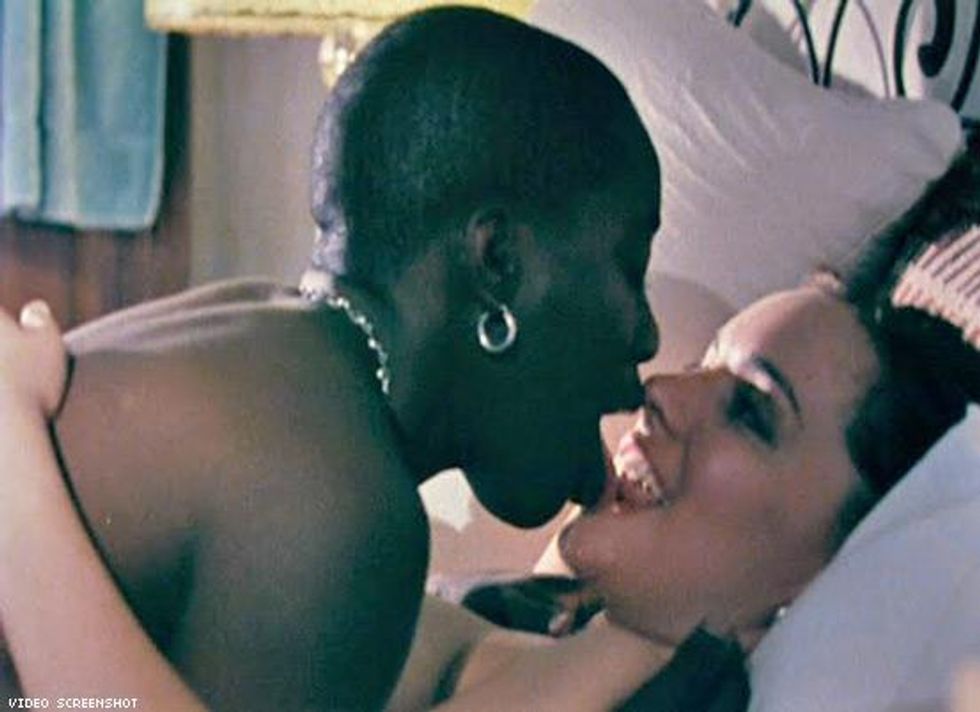
Cheryl Dunye became the first lesbian of color to direct herself in a lesbian love scene when she made The Watermelon Woman more than 20 years ago. In the film, Dunye plays a version of herself on a quest to find the story of a black "old Hollywood" actress who finds love with Guinevere Turner's Diana in the process. Thirty years old at the time, Dunye exposed her body and her vulnerability in the early interracial love scene with Turner. Dunye's camera direction offered sweet, sweeping crosses of their bodies intertwined celebrating the seduction that played out on screen long enough for viewers to enjoy the explorational intimacy the two women share. It also offered stark wide shots after the love-making in which Cheryl jumps out of bed to continue her film project, injecting the moment with comedy and conflict and reminding viewers that they are squarely in her story. -- Allison Tate
Bent (1997)

Based on Martin Sherman's 1979 play of the same name, Bent, a slang to refer to gay men in Nazi Germany, stars Clive Owen as Max, a gay man caught with his male lover during Hitler's rise to power, who is shipped off to a concentration camp. After enduring horrifying indignities, Max finds some solace in time spent with his work detail companion Horst (Lothaire Bluteau). The men, denied the ability to look at one another or to speak directly to each other, engage in a touchless sex scene whispered to each other as they stand shirtless under the watchful eyes of the Nazi guards. The scene in the film, the meaning of which arguably transitioned into a metaphor about HIV and AIDS for the time it was shot, is redemptive in its depiction of the men as vital and passionate despite their grim, hopeless environment. -- Tracy E. Gilchrist
Black Swan (2010)

When Mila Kunis's Lily went down on Natalie Portman's Nina in Black Swan, there was practically a collective moment when the entire audiences became aroused. The scene is groundbreaking, as it was one of the first lesbian sex scenes in a drama that was not strictly about queer people per se. One could argue that this scene may have just been the product of the male gaze at the hands of director Darren Aronofsky and/or a means to entice people (men) to see the film. However, the film unintentionally provided a nonthreatening pathway for queer women who weren't out to the world, let alone themselves, to explore lesbianism without having to explicitly search for lesbian content. -- Monica Rodman
Stranger by the Lake (2013)

A thriller that features a gay serial killer stalking a cruising area may not seem terribly groundbreaking. After all, when William Friedkin did it with the 1980 Al Pacino starrer Cruising, it was met with great outcry. But French filmmaker Alain Guiraudie delivers a taut, pristinely shot thriller in Stranger by the Lake, which follows the denizens of a lakeside cruising area where a serial killer walks among them. Pierre Deladonchamps plays Franck, a regular at the lake who becomes sexually involved with the sexy newcomer Michel (Christophe Paou). The sex in Stranger by the Lake is passionate, raw, and graphic and it doesn't shy away from full male nudity and erections. The scenes of Franck and Michel f***ing, juxtaposed with the natural landscape, make for timeless tableaus that comment on the beauty of not only the male form but of desire between men. -- Tracy E. Gilchrist
Bound (1996)

There's a moment in Bound when Violet (played by Jennifer Tilly with her full Betty Boop voice) sticks her fingers in Corky's mouth and guides them down between her own legs, and the audience is seduced along with the character. It's a sex scene that was choreographed by bisexual sexpert Susie Bright, who first-time (now out as trans) filmmakers the Wachowski sisters brought in to bring authenticity to the lesbian sex. She delivered not just a band of real-life dykes for the bar scene, but a real lesbisexual sensibility to the sex scenes, in part, because she knew what women did and did not want (like, um, lubrication and seduction).
And the sex between two women (one bi, one lesbian) moved the needle further in cinema, which previously had offered three options for lesbian sexuality: inauthentic, male gaze straight girl exploration (anything by Radley Metzger); frigid or unfulfilled daggers (The Children's Hour); or a lot of cutaways around lesbian sex (like the many other films with "where'd she go?" scenes that indicate oral sex had happened).
If all of that weren't enough, Corky, the ex-con plumber, is pure butch magnetism in the hands of Gina Gershon. She and the character offered one of the most authentic portrayals of female masculinity ever depicted on screen. -- Diane Anderson-Minshall
Duck Butter (2018)

Out actress Alia Shawkat (Transparent, Search Party) produced, cowrote, and starred in the thoroughly modern Duck Butter from director Miguel Arteta (The Good Girl, Chuck and Buck). Bucking the current trend of meeting possible paramours on dating apps that often urge swift judgment based on visual stimuli and a few quips, Duck Butter's Naima (Shawkat) and Sergio (Laia Costa) meet in real life at a queer bar where Sergio performs a song off-pitch but with loads of swagger. The two hang out and hook up before Sergio suggests they spend the next 24 hours together baring their souls and having an orgasm an hour. The pact is intended to sidestep the surface pleasantries of the incipient stages of dating, but instead it throws the couple headlong into feigning their best selves through manic exhaustion until they erupt in an argument.
Duck Butter's sex scenes go from passionate to desultory in the course of a 24-hour period in a metaphor for the flame-out of relationships over time. While the film is rife with sex scenes starring a queer woman playing queer who had a creative role in the movie, Duck Butter is freeing in its portrayal of queerness in a movie that's not necessarily about the act of being under the LGBTQ umbrella.
"Not to make it sound blase. It is obviously about lesbians, but it's not about their coming-out story. It's not about how the world relates to them differently, to them being gay, or to any struggles they've had to go through being gay, which was important for me to show," Shawkat told The Advocate this year. --Tracy E. Gilchrist

